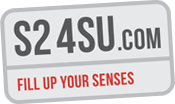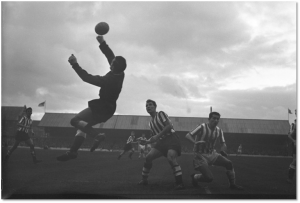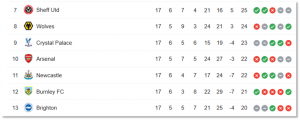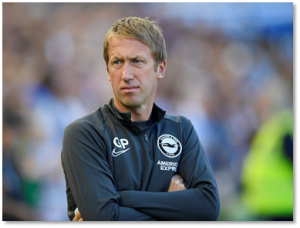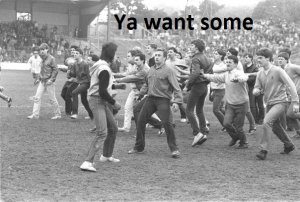grafikhaus
Kraft durch Freude
It’s almost fourteen years since we last met The Seagulls – a 3-1 home win for the Blades in the Championship - and we have only met them 24 times in the league and three times in the FA Cup since our first meeting on 7th January 1922.
If United avoid defeat at The Falmer Stadium - known for sponsorship purposes as the American Express Community Stadium, or colloquially as the Amex - (Kick-off 15:00 on Saturday 21st December), we will beat the record previously held by Blackburn Rovers in the 1992-93 season in being unbeaten in their first nine away games on their return to the Premier League. Rovers were the richest club in England at the time, boasting the country's most expensive player (Alan Shearer at over £3m).
Stadiums
Brighton & Hove Albion have played in four different ‘homes’ since they were elected to the Football League in 1920:
For 95 years Brighton and Hove Albion were based at the Goldstone Ground in Hove, until the board of directors decided to sell the stadium. The sale, implemented by majority shareholder Bill Archer and his chief executive David Bellotti, proved controversial, and the move provoked widespread protests against the board. The club received little if any money from this sale.
For two years, from 1997 to 1999, the club shared Priestfield Stadium, the ground of Gillingham, before returning to Brighton to play at Withdean Stadium. This was not predominantly a football ground, having been used for athletics throughout most of its history, and previously as a zoo.
Because of the cost of the public enquiry into planning permission for a new stadium, rent on Withdean Stadium, fees paid to use Gillingham's Priestfield Stadium, and a general running deficit due to the low ticket sales inherent with a small ground, the club had an accumulated deficit of £9.5 million in 2004.
Building of Falmer Stadium started in December 2008. On 31 May 2011 the club officially completed the handover and was given the keys to the stadium with an initial capacity of 22,374 seats, signifying the end of 12 years without a home. During January 2012, the club submitted an application to Brighton and Hove City council to increase the stadium capacity by a further 8,000 seats as well as to add additional corporate boxes, new television facilities and a luxury suite. This was granted unanimously by Brighton & Hove City Council's planning committee on 25 April 2012. The stadium was then expanded to 27,250 for the start of the 2012–13 season and then further to 27,750 during December 2012 before reaching 30,750 during May 2013.
Recent games against Brighton & Hove Albion:

Full history Sheffield United v Brighton
Possibly the most sensational game between the clubs came on 9th September 1989 when Dave Bassett’s Blades beat the Seagulls 5-4. 3-0 up after 31 minutes (Booker, 9 Deane, 14 Francis, 31) before Brighton made it 3-4 (Wood*, 34 Bremner, 48 Bremner, 64 and Wood* 68) before a 75th minute penalty by ‘Jock’ Bryson and an 89th-minute winner by Francis sent the 12,653 crowd wild in this Division Two encounter:
Here’s the programme:
And a (crap) panorama I took from the South Stand.
When I got home from the match, my dad asked if Brighton had any decent players. I said ‘That Paul Wood* looks decent.’ A few days later, we bought him.
On 1st February 1986, United beat Brighton 3-0 at Bramall Lane. Vid. is an hour long. Don’t bother:
If United avoid defeat at The Falmer Stadium - known for sponsorship purposes as the American Express Community Stadium, or colloquially as the Amex - (Kick-off 15:00 on Saturday 21st December), we will beat the record previously held by Blackburn Rovers in the 1992-93 season in being unbeaten in their first nine away games on their return to the Premier League. Rovers were the richest club in England at the time, boasting the country's most expensive player (Alan Shearer at over £3m).
Stadiums
Brighton & Hove Albion have played in four different ‘homes’ since they were elected to the Football League in 1920:
For 95 years Brighton and Hove Albion were based at the Goldstone Ground in Hove, until the board of directors decided to sell the stadium. The sale, implemented by majority shareholder Bill Archer and his chief executive David Bellotti, proved controversial, and the move provoked widespread protests against the board. The club received little if any money from this sale.
For two years, from 1997 to 1999, the club shared Priestfield Stadium, the ground of Gillingham, before returning to Brighton to play at Withdean Stadium. This was not predominantly a football ground, having been used for athletics throughout most of its history, and previously as a zoo.
Because of the cost of the public enquiry into planning permission for a new stadium, rent on Withdean Stadium, fees paid to use Gillingham's Priestfield Stadium, and a general running deficit due to the low ticket sales inherent with a small ground, the club had an accumulated deficit of £9.5 million in 2004.
Building of Falmer Stadium started in December 2008. On 31 May 2011 the club officially completed the handover and was given the keys to the stadium with an initial capacity of 22,374 seats, signifying the end of 12 years without a home. During January 2012, the club submitted an application to Brighton and Hove City council to increase the stadium capacity by a further 8,000 seats as well as to add additional corporate boxes, new television facilities and a luxury suite. This was granted unanimously by Brighton & Hove City Council's planning committee on 25 April 2012. The stadium was then expanded to 27,250 for the start of the 2012–13 season and then further to 27,750 during December 2012 before reaching 30,750 during May 2013.
Recent games against Brighton & Hove Albion:

Full history Sheffield United v Brighton
Possibly the most sensational game between the clubs came on 9th September 1989 when Dave Bassett’s Blades beat the Seagulls 5-4. 3-0 up after 31 minutes (Booker, 9 Deane, 14 Francis, 31) before Brighton made it 3-4 (Wood*, 34 Bremner, 48 Bremner, 64 and Wood* 68) before a 75th minute penalty by ‘Jock’ Bryson and an 89th-minute winner by Francis sent the 12,653 crowd wild in this Division Two encounter:
Here’s the programme:
And a (crap) panorama I took from the South Stand.
When I got home from the match, my dad asked if Brighton had any decent players. I said ‘That Paul Wood* looks decent.’ A few days later, we bought him.
On 1st February 1986, United beat Brighton 3-0 at Bramall Lane. Vid. is an hour long. Don’t bother:
-------------------------------------------------------------------------------------------------------------continued>>>
